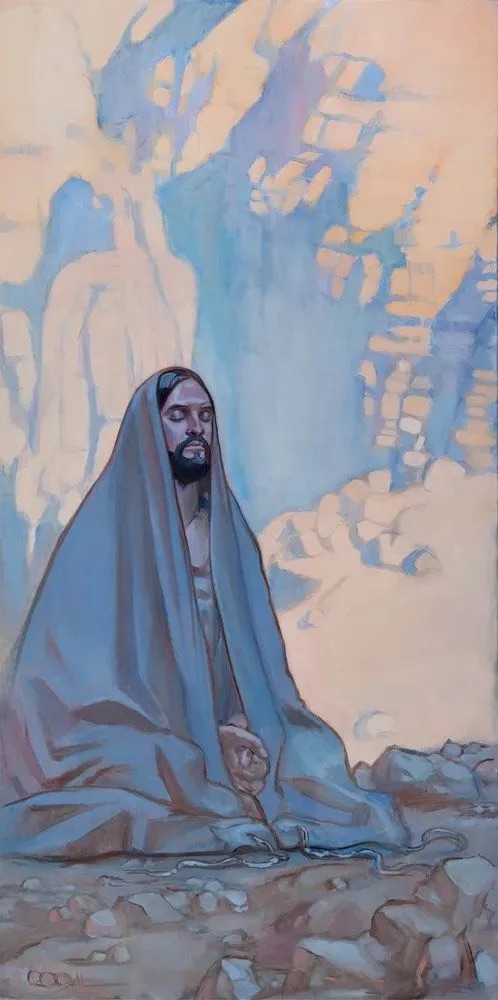
Long ago illiterate people relied on art to learn the faith. Churches were filled with sacred stained-glass windows and statues meant to convey truths and religious stories visually. Their beauty also lifted minds to God. As a child, I had a holy card collection, many of them with sacred art. Did you?
Viewing art is more than an intellectual experience. It has power to move our hearts. Think Michelangelo’s Pieta, Salvador Dali’s Christ of St. John of the Cross, or the 13th-century rose windows in Notre Dame Cathedral, which were spared in the tragic fire. They are called “rose” because they resemble this flower by their circular radiating form.
Sacred Reading and Sacred Viewing
Lectio Divina is a form of prayer in which you read Scripture or another spiritual book, be attuned to a phrase meant for you, reflect on it, and perhaps be lifted into contemplation.
A variation of this is Visio Divina, praying with an image, artwork, or a photograph. It follows the same steps:
- Read the image, slowly looking top to bottom or side to side, noticing details. Let some aspect touch your heart.
2. Meditate on the feature that has moved you. Ask yourself why it grabs your attention today. What might God be saying to you through it?
3. Speak to God about your thoughts.
4. Rest wordlessly in the presence of God.
Some people like to add a fifth stage, action. Your prayer may move you to undertake a certain action.
Icons Old and New

Iconography in Greek means “image writing.” Icons, the artwork mainly associated with Eastern Christianity, are meant to make you aware of God’s presence. They are known as “windows into heaven.” Rich in symbolism and rather stylized, icons are not to everyone’s taste. Shown here is the oldest known icon of Jesus titled “Pantocrator” (Ruler of the universe) and perhaps the most famous one of Mary: “Our Lady of Perpetual Help.” The traditional artist prays and fasts while painting an icon.

Today several artists provide modern icons. One prominent one is Brother Mickey McGrath, OSFS. His icon “Our Lady of Peace in Ukraine” is pictured here.

Daily Gospel-based Art
Each day among my emails is a post from Fr. Patrick van der Vorst that contains the daily Gospel reading along with a reflection on it and a piece of artwork related to it. Reading this post has become part of my spiritual exercises.

Corresponding to this week’s Gospel on fasting is the painting “Fasting in the Wilderness,” seen above. The artist, Rose Datoc Dall, did fast when she painted this one of Jesus in the desert preparing for his ministry. He is shown with his eyes closed and hands folded. He sits under a tallit, the Jewish prayer shawl. It forms a tent around him, cutting him off from distractions.
The tallit has a fringe on each corner, which is made of eight strands folded over. The four of them are a reminder to keep God’s commandments. You see them on the ground before Jesus. Some people mistakenly think these are snakes to symbolize of the temptations to come that he will repel. Around Jesus are the rocks he will refuse to turn into bread to break his fast. In the background are blurred people. What do you think they stand for? The painting’s message is that prayer and fasting are keys to spiritual power.
An Example of Visio Divina
If you were to do visio divina using Dall’s painting, look at it carefully. Then you might hone in on those fringes. They might call to mind a commandment you fail to obey. You might then ask God for forgiveness. Finally bask in knowing that the Father’s great mercy and love surround you.
You might give visio divina a try. Or create your own artwork. Or pray about God’s original artwork in the sky, forest, landscape, or garden!
I believe this link will take you to Fr. Patrick’s website: https://www.facebook.com/ChristianArt.Today/
• What are your favorite religious sculptures or paintings?









2 Responses
Timely is the nature of this news from you. Thanks.
As it happens, Fridays are on my calendar for reviewing and revising of current practices.
As Secular Franciscans are called to lead by example, we seculars practice strong prayer lives in accord with the time and circumstances we are given.
This morning before my daily Rosary (Sorrowful Mysteries), I read the following first: “It is sad to see how many people recite the Rosary. . . with incredible speed.” (Excerpted from “The Secret of the Rosary” by St. Louis Mary Grignion de Montfort.
So, Visio Divina fits with this secret of dwelling on the vision of oneself speaking to our Holy Mother Mary and God Our Father in Heaven.
As a result of your post, and, St. Louis’s comment, I pray that my Rosaries and vision will be conducted more reverently and lovingly.
I’m so glad my post was helpful to you. As a Sister of Notre Dame, I also pray a daily Rosary.